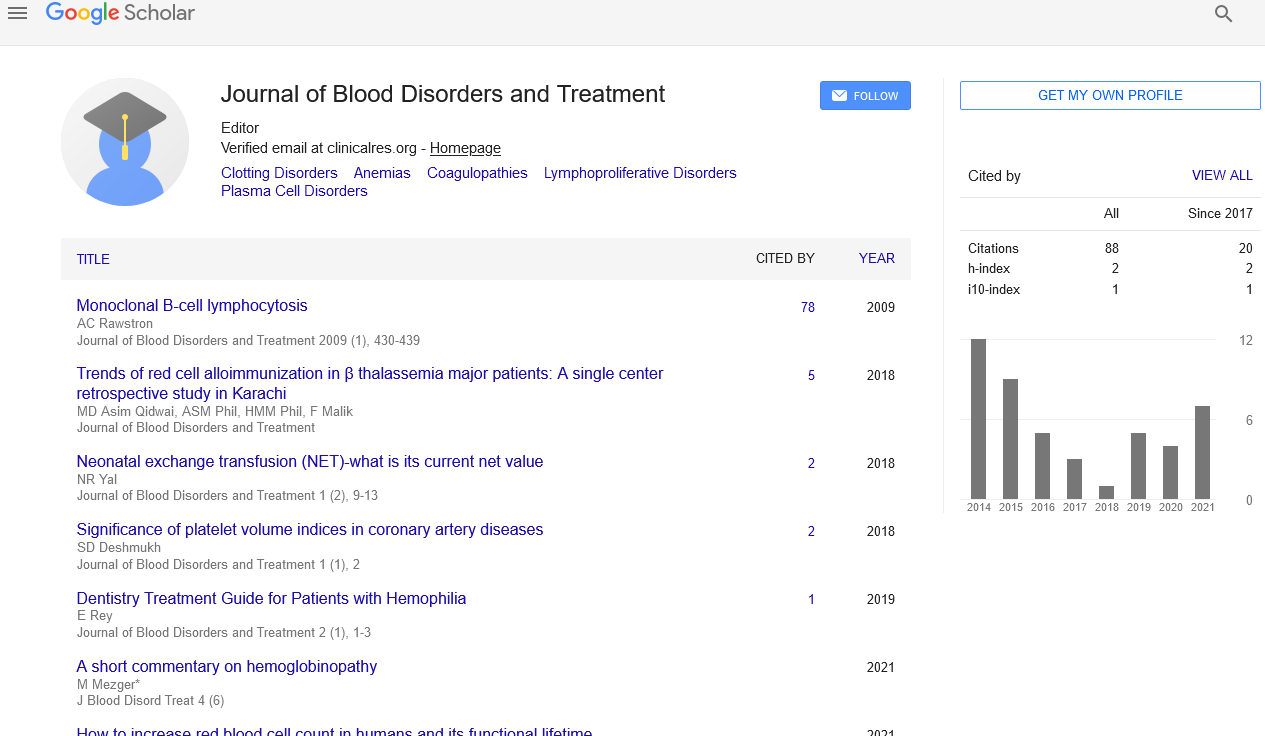Blood group antigens
Received: 05-Jul-2022, Manuscript No. PULJBDT-22-5956; Editor assigned: 07-Jul-2022, Pre QC No. PULJBDT-22-5956 (PQ); Accepted Date: Jul 20, 2022; Reviewed: 14-Jul-2022 QC No. PULJBDT-22-5956 (Q); Revised: 16-Jul-2022, Manuscript No. PULJBDT-22-5956 (R); Published: 24-Jul-2022, DOI: 10.37532/puljbdt.2022.6(4).3-4.
Citation: Collins A. Blood group antigens. J Blood Disord Treat.2022; 6(4):3-4.
This open-access article is distributed under the terms of the Creative Commons Attribution Non-Commercial License (CC BY-NC) (http://creativecommons.org/licenses/by-nc/4.0/), which permits reuse, distribution and reproduction of the article, provided that the original work is properly cited and the reuse is restricted to noncommercial purposes. For commercial reuse, contact reprints@pulsus.com
Abstract
Blood group antigens are polymorphic protein or carbohydrate residues on the surface of red blood cells. They can elicit an antibody response in people who don't have them, and some antibodies can result in a hemolytic transfusion reaction or fetal/newborn hemolytic disease.
Key Words
Hemolytic; Polymorphic; Coagulation
Introduction
Many red cell blood group antigens have a molecular basis, and an actively maintained database currently lists over 1,600 alleles of 44 genes. The red cell phenotype is the antigen complement on the red cell surface. This term refers to the status of clinically significant antigens other than ABO and Rh in transfusion practise. Red cell phenotype testing of blood donors and donor RBC units is used to identify antigen-negative units for transfusion, usually for patients with red cell antibodies, but also for transfusion-dependent patients who do not have antibodies, to prevent allo-immunization. Serological typing with specific antisera using direct or indirect hemagglutination is used for phenotype testing.
Serological typing methods are straightforward, but they require dependable typing antisera, and typing for multiple antigens is timeconsuming. Patients' red cell phenotype testing is used selectively to supplement routine pre-transfusion testing. It is prescribed for patients who have or are at risk of developing multiple antibodies. Knowing which antigens are missing allows for an evaluation of the patient's ability to produce antibodies. The phenotype is then used to select matched, antigen-negative RBC units, avoiding further alloimmunization and exposure to foreign antigens.
However, if the patient has recently been transfused, standard serological typing cannot be used because donor red blood cells can remain in the circulation for up to 3 months after transfusion. Furthermore, if the patient has a positive Direct Anti-Globulin Test (DAT), standard serological typing cannot be used for many antigens because only antigens detectable by direct agglutination can be typed. Specialized serological methods can overcome these constraints, but they are not always effective.
Platelets are not cells, but rather fragments of larger multinucleated cells found in bone marrow known as megakaryocytes. Platelets play an important role in normal blood clotting.
Blood Donor Molecular Typing
Single nucleotide polymorphisms control the expression of many clinically important antigens (SNPs). Detecting these SNPs can predict the phenotype of red blood cells and is an alternative to serological typing. Multiple SNPs can be included in a single assay, allowing for efficient antigen screening. As a result, molecular typing is ideal for mass screening of blood donors, and it is expected to significantly increase the pool of blood donors (and donor RBC units) who are negative for multiple antigens or a high-prevalence antigen. When typing antisera are unavailable, molecular typing can be used to identify antigen-negative donors. Typing antisera for the Dob antigen (Dombrock group), for example, are notoriously unreliable, whereas molecular typing for the DO gene mutation, 793A>G, that encodes the Dob antigen is a superior method of identifying Dob-negative donors for the patient with anti-Dob. This molecular typing feature has also been used to better characterise the reagent cell panels used for patient antibody identification.
Transfusion Recipient Molecular Typing
DNA isolated from peripheral white blood cells is typically used for molecular typing. Because this sample is unaffected by donor blood or antibodies on the red cell surface, molecular typing is an excellent method for determining the phenotype when the patient has recently been transfused or has positive DAT. The following examples demonstrate how molecular typing can be used. Females of child-bearing potential with low D or D typing discrepancies are prime candidates for molecular typing, as this is the only way to distinguish between low D antigen expression (no risk of allo-immunization) and partial D antigen expression. Molecular typing may be used to determine the antigen status of the foetus in an alloimmunized prenatal patient. Except for D, the father's antigen type by serology is used to predict the antigen status of the foetus for the common antigens. If the father is antigen-negative and paternity is established, the foetus is likely to be antigen-negative as well, and thus not at risk for HDFN from the mother's antibody. The quality of the DNA sample influences the results of molecular typing, which can be unreliable in samples with low DNA concentration. In stem cell transplant recipients, who may have multiple populations of cells in their peripheral blood, results should be interpreted with caution. Typing on alternative samples, such as a buccal smear, may aid in the interpretation of such cases.
Molecular assays do not test for every possible polymorphism, and as previously stated, false positive antigen status can occur if a mutation that affects antigen expression, such as an unusual polymorphism or a mutation in a regulatory gene, is not represented on the assay. This is especially concerning for members of racial/ethnic minorities. The predicted phenotype must be investigated if it differs from the patient's known antibodies or serological phenotype.
Although serological testing is still the mainstay of the blood bank and transfusion medicine laboratory, molecular typing is a valuable supplement to traditional methods. Some administrative and logistical issues with molecular typing remain unresolved, such as high costs, slow turnaround, the need for specialised equipment and technologists, and the lack of information systems to handle the results.





